The classical guitars, also popular as Spanish guitars, nylon-string guitars, classical acoustic and concert guitars, are a part of the guitar family that is used in classical music. This instrument is an acoustic guitar made of wood with nylon strings as opposed to the strings in electric and acoustic guitars which are made of metal. The regular classical guitars come with twelve frets clear of the body, and it is placed on the left leg of the player in order for the hand to fall at the soundhole’s back – this position is called classical. The contemporary guitar with steel strings, on the other hand, comes in most cases with fourteen frets clear of the body (like the Dreadnought) and is usually played on the hip.
The phrase classical guitars can also be used for two other meanings:
- The finger technique applied to classic guitar – you pluck the individual strings with your fingernails and more rarely – with your fingertips.
- The music repertoire of this guitar.
The material, construction and shape of classical guitars are variable, but usually, they come with a modern classical guitar shape, or they could also come with historic classical guitar shape which resembles some early romantic guitar models from Italy and France. The strings of classical guitars were previously made of catgut, and in more recent times and currently, they are made of polymers, basically nylon and there is a fine silver wire which is wound on the strings on the bass side.
 You can identify a guitar family tree. A derivation of the modern classical is the flamenco guitar, but there are differences in sound, construction and material.
You can identify a guitar family tree. A derivation of the modern classical is the flamenco guitar, but there are differences in sound, construction and material.
In some cases, the term modern classical guitars is used to separate the classical guitars from other, older types of guitar which are also called classical in the broadest meaning, or more specifically – early guitars. Some examples of such instruments are the earlier baroque guitars with five courses and the early romantic guitar with six strings.
The contemporary modern classical guitars took their current shape from the nineteen century Spanish Luthier Antonio Torres Jurado’s late designs.
There are people who have a preference for a clasical guitar when learning how to play a guitar as opposed to an acoustic guitar or an electric guitar. This guitar offers distinct sound and it is quite easier on your fingers if you are a beginner. These instruments are also very common for initial finger style guitar playing.
Several Obvious Differences
You can find several obvious differences between acoustic/electric guitars and the classical guitars. Take a look at them:
- A neck which is wider – yes, these guitars come with wider neck than the others, and the reason is to provide more space between the strings and also to make it harder for small hands.
- A neck which is shorter – the classical guitar’s neck meets the body at the twelfth fret, most electric and acoustic guitars, on the other hand, connect at the fourteenth fret.
- The nylon strings – electric and acoustic guitars come with steel strings, and classical guitars come with nylon strings. These strings are gentler on your fingers and create a different sound than the steel ones, but they also need time for getting used to.
- The soundhole rosette – despite that it has a purely aesthetic purpose, most of the clasical guitars are beautifully decorated around their sound hole, something not seen on an electric or acoustic guitar.
The Buyers Guide for Classical Guitar Beginners
If you are looking to buy classical guitars, you should consider a few essential features before making your purchase. These are:
- The guitar’s shape and size.
- The strings made of nylon.
- The guitar’s projection.
- The tuning machines quality.
The guitar’s shape and size
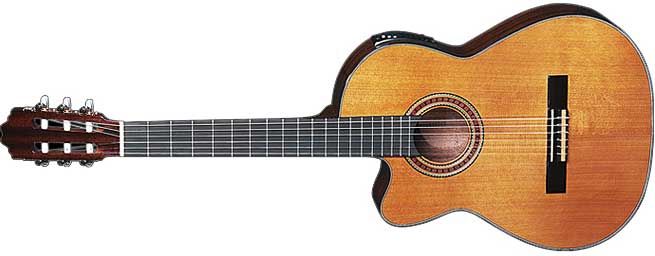 Like most of the beginner guitars, classical guitars for sale have various sizes and shapes. You can find smaller guitars suitable for kids but not for grown up people. Moreover, the very wide neck typical for a full-size classical guitar may be difficult for a kid to learn on.
Like most of the beginner guitars, classical guitars for sale have various sizes and shapes. You can find smaller guitars suitable for kids but not for grown up people. Moreover, the very wide neck typical for a full-size classical guitar may be difficult for a kid to learn on.
The guitar’s shape has a great impact on its sound and its projection. A thin body guitar creates a lesser sound having more treble while a thick body guitar creates bass notes that sound out. And, as a conclusion of this section, your guitar’s shape depends on your individual preference. For example, some classical guitars for sale appear longer and this is not quite pleasing to some players.
The strings made of nylon
The strings made of nylon are a different kind. They create an absolutely different sound and feeling than the strings made of steel. One positive aspect is that it is much easier to push them down with your fingertips and this is a basic advantage if you are a beginner.
A drawback if you want to buy classical guitar, on the other hand, is that their sound is not as edgy as that of the steel strings guitars. If you are looking forward to using a pick in order to produce the chunk sound, these strings would not be the appropriate choice.
As a conclusion of this section, and this is something to bear in your mind, to string such guitar is an absolutely different operation than to string an electric guitar or an acoustic guitar. Be ready to get to know new methods that are not known to most musicians who are not familiar with this instrument.
The projection of the classical guitar for sale
This aspect is quite often underestimated by many beginners who want to buy classical guitar. They consider the sound quality while fingerpicking and the size, but the projection is entirely forgotten. What is projection? This is the classical guitar’s sound’s ability to keep its power of sound without its clarity and quality being distorted.
If you intend to buy classical guitar for sale and play it in public, the projection is essential quality to consider. The best way to test the projection is comparing your guitar with another one having good projection. If, however, this is not possible for you, have another person with you who will listen how the guitar sounds in open space.
The tuning machines quality
The classical guitar’s tuning machines are pretty different than the ones on an electric guitars or acoustic guitars. They are quite more susceptible to slipping, especially when it comes to lesser quality instruments and this could result in a guitar that is out of tune.
You should test the tuning pegs to ensure that there is no slippage and they run cleanly. You should wind and then unwind them to check if there are any catches or jumps in the mechanism. This is a simple way to avoid the possible getting out of tune with your guitar and this way you can avoid the common frustration that easily out tuned guitars cause.
More Information About Classical Guitars for Sale
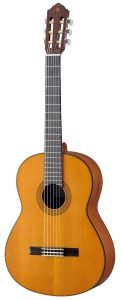 Despite the common appearance of Flamenco and Classical guitars, they have some differences, and this means that different setups are required.
Despite the common appearance of Flamenco and Classical guitars, they have some differences, and this means that different setups are required.
There are different materials used for the construction and voicing, and there are differences in the set up of the string clearance and the neck angle’s geometry.
In general, classic guitars come with high string clearances and a firmly structured soundboard in order to project a pretty clear tone when a lot of contrapuntal musical voices are being performed.
The flamenco guitar, though, requires a highly accurate neck angle’s geometry and low string clearances usually set up with a string clearance of eight millimeters at the bridge from the soundboard in order to facilitate percussive techniques and the rapid rascuedo that are common for flamenco music. The soundbox is produced with a loose voicing so it could assist in fast, bright attack of the note. The most exquisite flamenco and classic guitars are produced by individual makers.
Tension of the strings
The relation between the soundboard and the string tension is sensitive. The methods for construction, the material selection, bracing patterns and soundboard thickness all affect the response, feel and tension in the string. It means that the tension of the strings is variable between different guitars.
It is very common for musicians who play regular concert classic guitars to use strings with high clearance and hard tension. This is done in order a broad dynamic range to be achieved – soft to loud (or pianoforte), requiring a strong and well-honed technique.
The flamenco players prefer normal string tension because the lighter tension makes the rapid passages playing easier. However, all depends on the player and particular guitar.
Until recently, strings for modern classical guitars were available just in four tensions – light, normal, hard and extra hard, all of them made from nylon trebles nylon strands wound with silver plated copper for bass. In more recent times, there is a rise in popularity of carbon treble strings.
The traditional strings made of nylon provide individual voices between all of the six strings. Contemporary strings made of carbon treble, however, provide a faster attack, brighter similar to metallic sound and are the preferred choice of musicians having modern lattice braced guitars with light soundboard construction.
Open strings tuning
Guitars are usually tuned to concert pitch and the A note above the middle C vibrates at four hundred and forty cycles per second as a standard.
Scale length
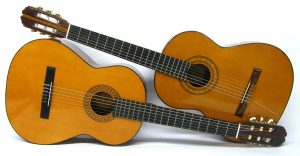 The guitar’s scale length is the vibrating string’s length measured from nut to saddle, or alternatively, twice the length from the nut to the twelfth fret. If we assume that everything else is equal (gauge and pitch of the strings) the longer the length of the scale is, the bigger the strings tension will be.
The guitar’s scale length is the vibrating string’s length measured from nut to saddle, or alternatively, twice the length from the nut to the twelfth fret. If we assume that everything else is equal (gauge and pitch of the strings) the longer the length of the scale is, the bigger the strings tension will be.
During the Spanish guitar’s development, various scale lengths have been used, from 630 to 700 millimeters. In the 19th century, the father of the contemporary Spanish guitar, Antonio Torres De Jurado, standardized and adopted the six hundred and fifty millimeters scale length. From then on, this is a standard scale length. On the other hand, there are some artisan variations, but guitars with longer scale are more demanding in general when it comes to playing them.
Fret wire dimension/size
This is the fret wire’s width and height. A regular selection on flamenco and classical guitars is a medium fret wire which averages two millimeters wide and 0.9 millimeters tall, quite close to the travel guitar.
Surface of the fingerboard
Most flamenco and classical guitars come with a flat fingerboard tapering in thickness in order to accommodate the big motion of the strings.
String clearance or action
The term action is a general one, used to describe the distribution of strings across the fingerboard. The higher the position of the strings from the frets is, the bigger force is needed to fret the string; and conversely – the lower the position of the strings from the frets is, the less force is needed to fret the string. Various guitars and various playing styles will determine the different set-ups.
The regulation of action is determined by the distribution of string clearances at the bridge, nut, the amount of neck curvature and the bridge saddle’s profile.
The neck relief, or deliberate neck curvature
This is the amount of concave bow in the neck (which dips in the middle) that can facilitate the creation of action that is relatively buzz free. You can determine the amount of neck relief by adjusting the tension of the truss rod.
String length compensation or intonation
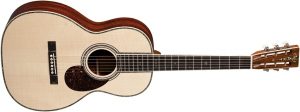 When you depress a string in order to play a note, you are stretching the string. By stretching it, the note’s pitch sounds sharper and therefore a correction is needed for the compensation for the discrepancy. It means that the intonation is this state of the guitar when it is in tune with itself harmoniously, in most cases this is done by setting the length of the strings at this point where the bridge saddle and the string cross each other.
When you depress a string in order to play a note, you are stretching the string. By stretching it, the note’s pitch sounds sharper and therefore a correction is needed for the compensation for the discrepancy. It means that the intonation is this state of the guitar when it is in tune with itself harmoniously, in most cases this is done by setting the length of the strings at this point where the bridge saddle and the string cross each other.
Tempering is a term used for describing the act of balancing the between strings pitch relationships so the guitar can intonate in an even way over the whole fingerboard.
Neck and soundboard flexibility
Rubbery or weak surfaces that vibrate create musical notes that sound unstable and it means that it is better to use a stiff vibrating surface. On the opposite extreme side, the vibrating components that are thinner can be susceptible to moving, and the humidity and temperature changes can affect them. Flexible and thin guitars create notes warbling with unclear upper partials which makes it very hard to accurately distinguish and tune the strings to pitch. The design of quality guitars balances weight to stiffness.
Bridges
Flamenco and classic guitar bridges are made using a single piece of hardwood, usually rosewood. The saddle is made of bone in traditional models and more recently newly produced instruments use molded synthetic materials.
The saddle is placed into the bridge, and the manufacturer has predetermined the angle and length. There is a possibility of improving the intonation by producing a saddle that comes with lengths that are calibrated for each particular string on the classical guitar.
A short Classical Guitars History
The earliest guitar’s origins are a mystery. The Hittites for example, played a stringed instrument having a long neck, body and waist more than three thousand and four hundred years ago.
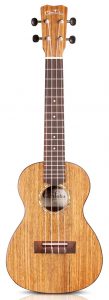 It is well known that throughout the fifteenth century, there was a development of a guitar resembling instrument in Spain which was called viola da mano or vihuela. Genteel people played this instrument. Also, there was a similar instrument, although with different tuning, which was called ghiterne or guiterra and the common people used it. And by the 1550 the two kinds had become one instrument. It came with eight strings which were tuned as four pairs or courses. There was an addition of a fifth course by the end of the sixteenth century. It has also increased its popularity in other countries where it became popular as Spanish guitar.
It is well known that throughout the fifteenth century, there was a development of a guitar resembling instrument in Spain which was called viola da mano or vihuela. Genteel people played this instrument. Also, there was a similar instrument, although with different tuning, which was called ghiterne or guiterra and the common people used it. And by the 1550 the two kinds had become one instrument. It came with eight strings which were tuned as four pairs or courses. There was an addition of a fifth course by the end of the sixteenth century. It has also increased its popularity in other countries where it became popular as Spanish guitar.
One of the wonderful positive aspects of the guitar in comparison to the lute was that it was quite easier to be played. Folks who had a mediocre ability to play music liked that they were able to quickly learn a few chords and this fact was despised by the ones who assumed they possessed cultured tastes. Many commentators expressed disappointment from the guitar and its sound, but this instrument grew in popularity in the next centuries.
Around the beginning of the nineteenth century, there was a replacement of the five courses with six single strings which were tuned in a way that is common nowadays. Before this alteration, the instrument had quite a narrow body and was somehow quiet. It should be noted that with the advent of the piano, there was e steep decline of guitar’s popularity, but there were new developments waiting to take place.
Around 1940, Antonio de Torres, the Spanish carpenter began producing guitars. He brought a revolution in the guitar’s sound by providing his guitars with a quite bigger body than all previous variants. He also developed a fan struts pattern – they were glued below the soundboard and thus enhancing its tone and strengthening it as well. This person apparently had unique sensitivity to the wood’s acoustic aspects. Despite that plenty of his wood was derived from old furniture dismantled by him, there are few makers since then that have succeeded to create a similar character, sonority and the beautiful sound of his guitars. Despite that there are contemporary makers employing new patterns of strutting, the design by Torres still defines the fundament of most fan strutting used up until now and many people consider him the quintessential classical guitar master. We hope that our article will help you make the classical guitar sale you are looking for.
Detailed Information About the Classical Guitar
- Early Classical Guitar and Early Romantic Guitar Time Period (Guitar Music in the 4 Time Periods)
- Function, Construction and Quality of The Guitar (Committee for the Acoustics of Music)
